Creative Problem Solving: Air Pollution and Human Health in India
VerifiedAdded on 2023/01/19
|22
|5389
|55
Project
AI Summary
This coursework project delves into the critical issue of air pollution in India, examining its multifaceted impacts on human health and the environment. The project begins with a comprehensive overview of the problem situation, highlighting the severity of air pollution levels and the primary contributing factors such as dust, construction, waste burning, transportation, industrial emissions, and domestic cooking. It then identifies key stakeholders involved in the problem, including local residents, government bodies, international organizations, and environmental agencies. A detailed rich picture is presented to visually represent the complex interplay of factors contributing to air pollution. The project focuses on the human health effects of air pollution, including lung diseases, cancer, cardiovascular issues, central nervous system damage, and immune system problems. The chosen methodology for analyzing the problem is the soft systems methodology (SSM), which is used to examine the varied perspectives on the causes and effects of air pollution. The project defines the P, Q, and R components of the analysis and utilizes the CATWOE criteria to identify the victims, actors, transformation process, world view, owner, and environmental constraints related to the problem. A root definition is formulated to clearly state the core issue. The project concludes with recommendations for addressing the problem, drawing on the analysis conducted. The goal is to provide a well-structured understanding of the air pollution crisis and suggest effective strategies to curb its adverse effects.
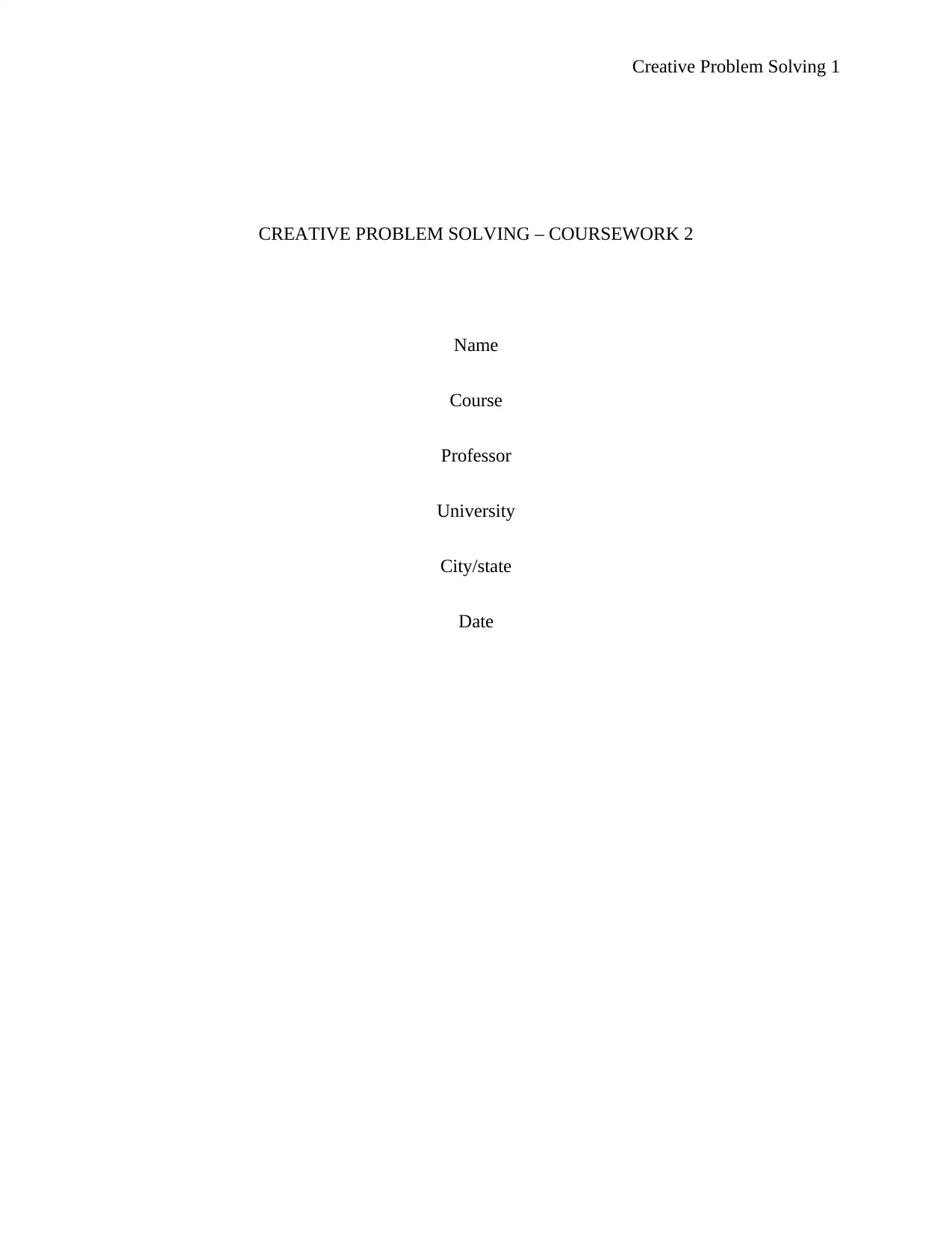
Creative Problem Solving 1
CREATIVE PROBLEM SOLVING – COURSEWORK 2
Name
Course
Professor
University
City/state
Date
CREATIVE PROBLEM SOLVING – COURSEWORK 2
Name
Course
Professor
University
City/state
Date
Paraphrase This Document
Need a fresh take? Get an instant paraphrase of this document with our AI Paraphraser
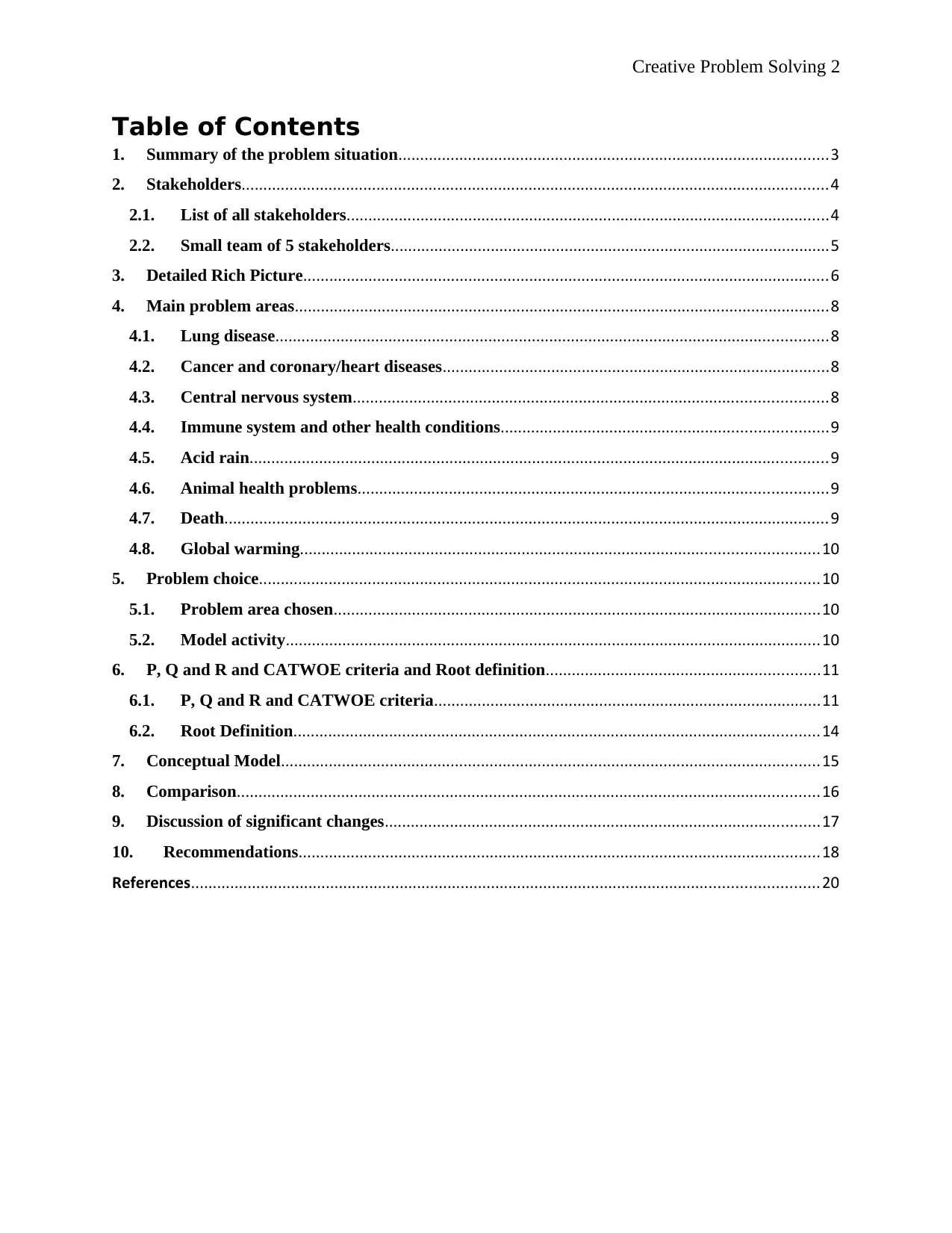
Creative Problem Solving 2
Table of Contents
1. Summary of the problem situation...................................................................................................3
2. Stakeholders.......................................................................................................................................4
2.1. List of all stakeholders...............................................................................................................4
2.2. Small team of 5 stakeholders.....................................................................................................5
3. Detailed Rich Picture.........................................................................................................................6
4. Main problem areas...........................................................................................................................8
4.1. Lung disease...............................................................................................................................8
4.2. Cancer and coronary/heart diseases.........................................................................................8
4.3. Central nervous system.............................................................................................................8
4.4. Immune system and other health conditions...........................................................................9
4.5. Acid rain.....................................................................................................................................9
4.6. Animal health problems............................................................................................................9
4.7. Death...........................................................................................................................................9
4.8. Global warming.......................................................................................................................10
5. Problem choice.................................................................................................................................10
5.1. Problem area chosen................................................................................................................10
5.2. Model activity...........................................................................................................................10
6. P, Q and R and CATWOE criteria and Root definition...............................................................11
6.1. P, Q and R and CATWOE criteria.........................................................................................11
6.2. Root Definition.........................................................................................................................14
7. Conceptual Model............................................................................................................................15
8. Comparison......................................................................................................................................16
9. Discussion of significant changes....................................................................................................17
10. Recommendations........................................................................................................................18
References................................................................................................................................................20
Table of Contents
1. Summary of the problem situation...................................................................................................3
2. Stakeholders.......................................................................................................................................4
2.1. List of all stakeholders...............................................................................................................4
2.2. Small team of 5 stakeholders.....................................................................................................5
3. Detailed Rich Picture.........................................................................................................................6
4. Main problem areas...........................................................................................................................8
4.1. Lung disease...............................................................................................................................8
4.2. Cancer and coronary/heart diseases.........................................................................................8
4.3. Central nervous system.............................................................................................................8
4.4. Immune system and other health conditions...........................................................................9
4.5. Acid rain.....................................................................................................................................9
4.6. Animal health problems............................................................................................................9
4.7. Death...........................................................................................................................................9
4.8. Global warming.......................................................................................................................10
5. Problem choice.................................................................................................................................10
5.1. Problem area chosen................................................................................................................10
5.2. Model activity...........................................................................................................................10
6. P, Q and R and CATWOE criteria and Root definition...............................................................11
6.1. P, Q and R and CATWOE criteria.........................................................................................11
6.2. Root Definition.........................................................................................................................14
7. Conceptual Model............................................................................................................................15
8. Comparison......................................................................................................................................16
9. Discussion of significant changes....................................................................................................17
10. Recommendations........................................................................................................................18
References................................................................................................................................................20
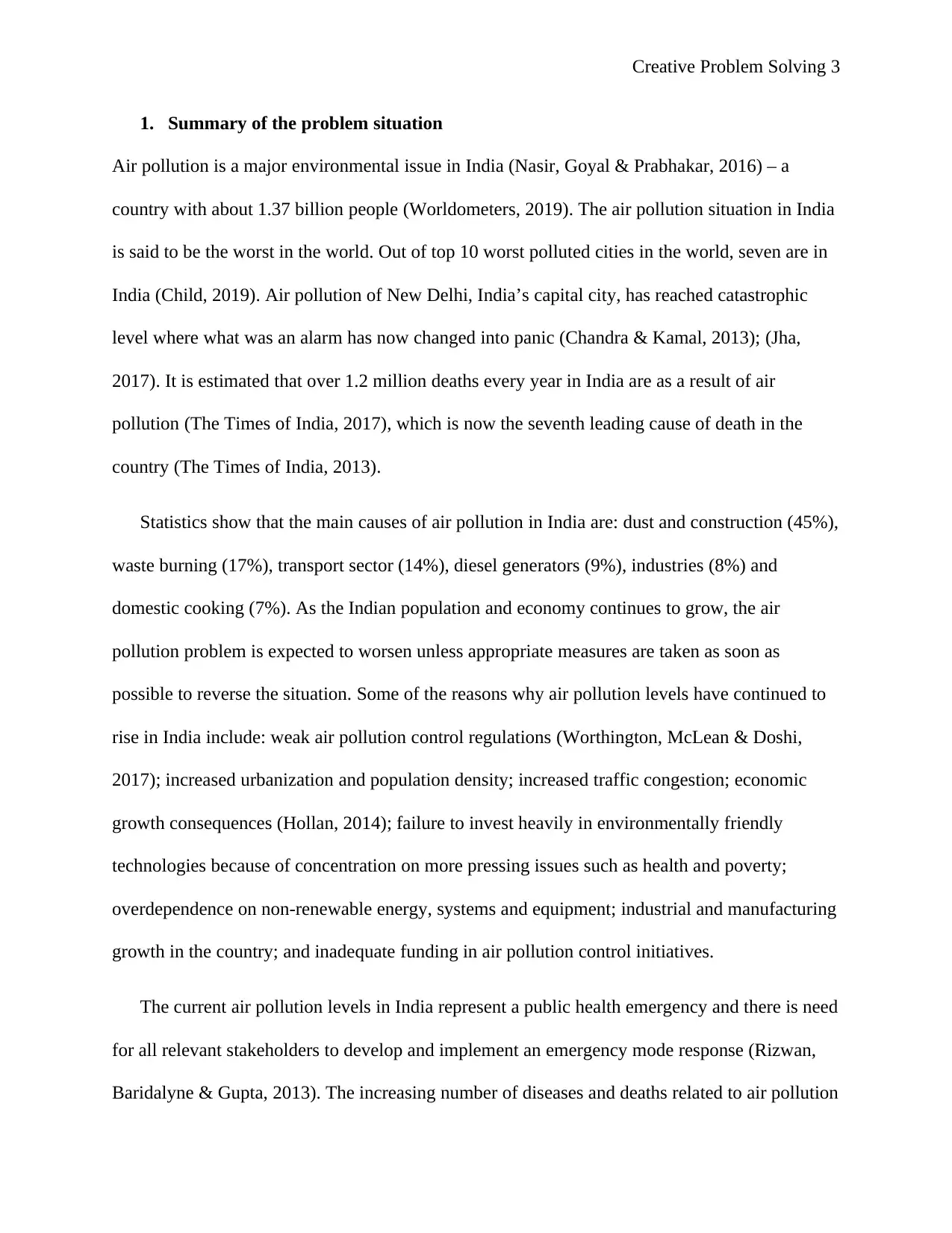
Creative Problem Solving 3
1. Summary of the problem situation
Air pollution is a major environmental issue in India (Nasir, Goyal & Prabhakar, 2016) – a
country with about 1.37 billion people (Worldometers, 2019). The air pollution situation in India
is said to be the worst in the world. Out of top 10 worst polluted cities in the world, seven are in
India (Child, 2019). Air pollution of New Delhi, India’s capital city, has reached catastrophic
level where what was an alarm has now changed into panic (Chandra & Kamal, 2013); (Jha,
2017). It is estimated that over 1.2 million deaths every year in India are as a result of air
pollution (The Times of India, 2017), which is now the seventh leading cause of death in the
country (The Times of India, 2013).
Statistics show that the main causes of air pollution in India are: dust and construction (45%),
waste burning (17%), transport sector (14%), diesel generators (9%), industries (8%) and
domestic cooking (7%). As the Indian population and economy continues to grow, the air
pollution problem is expected to worsen unless appropriate measures are taken as soon as
possible to reverse the situation. Some of the reasons why air pollution levels have continued to
rise in India include: weak air pollution control regulations (Worthington, McLean & Doshi,
2017); increased urbanization and population density; increased traffic congestion; economic
growth consequences (Hollan, 2014); failure to invest heavily in environmentally friendly
technologies because of concentration on more pressing issues such as health and poverty;
overdependence on non-renewable energy, systems and equipment; industrial and manufacturing
growth in the country; and inadequate funding in air pollution control initiatives.
The current air pollution levels in India represent a public health emergency and there is need
for all relevant stakeholders to develop and implement an emergency mode response (Rizwan,
Baridalyne & Gupta, 2013). The increasing number of diseases and deaths related to air pollution
1. Summary of the problem situation
Air pollution is a major environmental issue in India (Nasir, Goyal & Prabhakar, 2016) – a
country with about 1.37 billion people (Worldometers, 2019). The air pollution situation in India
is said to be the worst in the world. Out of top 10 worst polluted cities in the world, seven are in
India (Child, 2019). Air pollution of New Delhi, India’s capital city, has reached catastrophic
level where what was an alarm has now changed into panic (Chandra & Kamal, 2013); (Jha,
2017). It is estimated that over 1.2 million deaths every year in India are as a result of air
pollution (The Times of India, 2017), which is now the seventh leading cause of death in the
country (The Times of India, 2013).
Statistics show that the main causes of air pollution in India are: dust and construction (45%),
waste burning (17%), transport sector (14%), diesel generators (9%), industries (8%) and
domestic cooking (7%). As the Indian population and economy continues to grow, the air
pollution problem is expected to worsen unless appropriate measures are taken as soon as
possible to reverse the situation. Some of the reasons why air pollution levels have continued to
rise in India include: weak air pollution control regulations (Worthington, McLean & Doshi,
2017); increased urbanization and population density; increased traffic congestion; economic
growth consequences (Hollan, 2014); failure to invest heavily in environmentally friendly
technologies because of concentration on more pressing issues such as health and poverty;
overdependence on non-renewable energy, systems and equipment; industrial and manufacturing
growth in the country; and inadequate funding in air pollution control initiatives.
The current air pollution levels in India represent a public health emergency and there is need
for all relevant stakeholders to develop and implement an emergency mode response (Rizwan,
Baridalyne & Gupta, 2013). The increasing number of diseases and deaths related to air pollution
⊘ This is a preview!⊘
Do you want full access?
Subscribe today to unlock all pages.

Trusted by 1+ million students worldwide
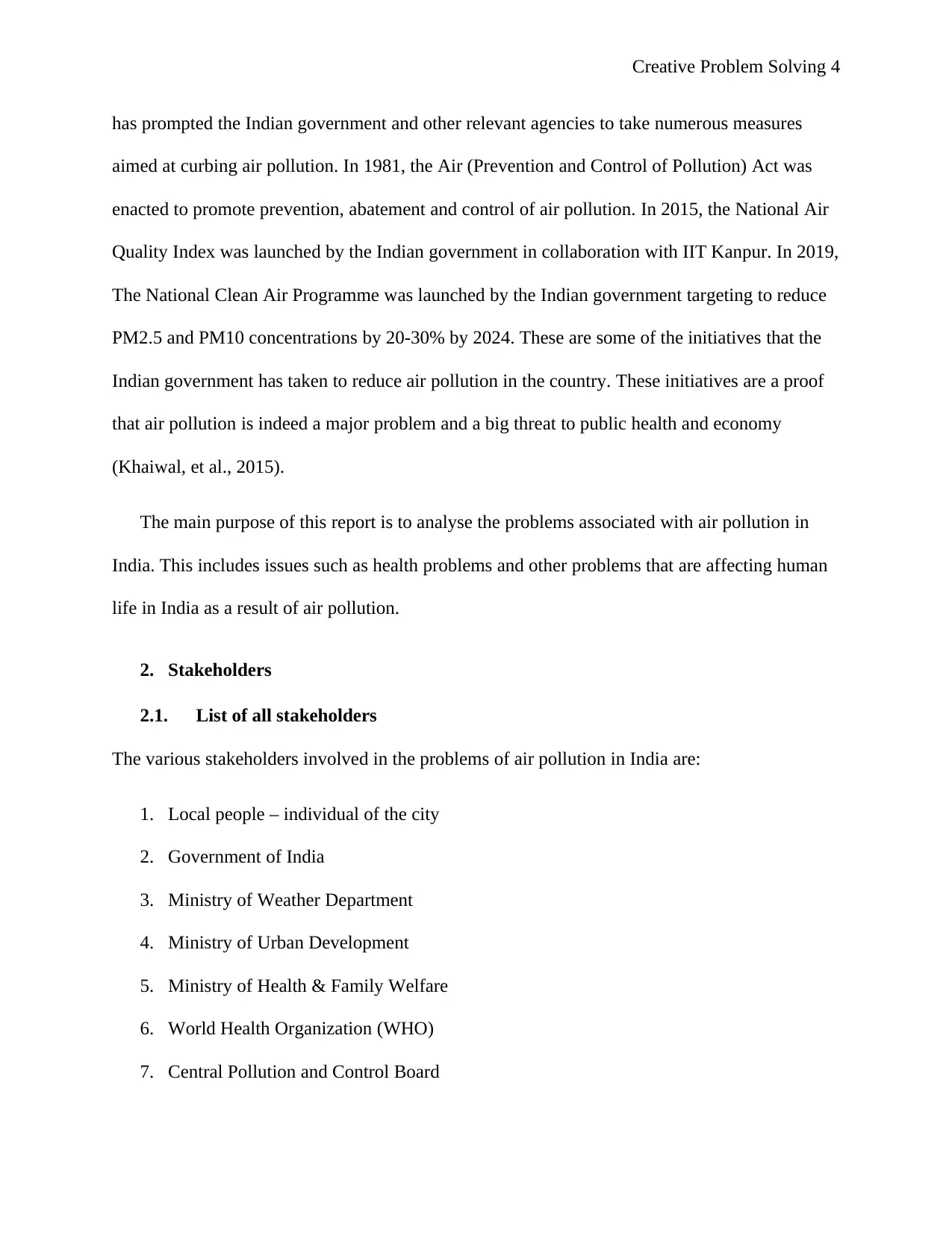
Creative Problem Solving 4
has prompted the Indian government and other relevant agencies to take numerous measures
aimed at curbing air pollution. In 1981, the Air (Prevention and Control of Pollution) Act was
enacted to promote prevention, abatement and control of air pollution. In 2015, the National Air
Quality Index was launched by the Indian government in collaboration with IIT Kanpur. In 2019,
The National Clean Air Programme was launched by the Indian government targeting to reduce
PM2.5 and PM10 concentrations by 20-30% by 2024. These are some of the initiatives that the
Indian government has taken to reduce air pollution in the country. These initiatives are a proof
that air pollution is indeed a major problem and a big threat to public health and economy
(Khaiwal, et al., 2015).
The main purpose of this report is to analyse the problems associated with air pollution in
India. This includes issues such as health problems and other problems that are affecting human
life in India as a result of air pollution.
2. Stakeholders
2.1. List of all stakeholders
The various stakeholders involved in the problems of air pollution in India are:
1. Local people – individual of the city
2. Government of India
3. Ministry of Weather Department
4. Ministry of Urban Development
5. Ministry of Health & Family Welfare
6. World Health Organization (WHO)
7. Central Pollution and Control Board
has prompted the Indian government and other relevant agencies to take numerous measures
aimed at curbing air pollution. In 1981, the Air (Prevention and Control of Pollution) Act was
enacted to promote prevention, abatement and control of air pollution. In 2015, the National Air
Quality Index was launched by the Indian government in collaboration with IIT Kanpur. In 2019,
The National Clean Air Programme was launched by the Indian government targeting to reduce
PM2.5 and PM10 concentrations by 20-30% by 2024. These are some of the initiatives that the
Indian government has taken to reduce air pollution in the country. These initiatives are a proof
that air pollution is indeed a major problem and a big threat to public health and economy
(Khaiwal, et al., 2015).
The main purpose of this report is to analyse the problems associated with air pollution in
India. This includes issues such as health problems and other problems that are affecting human
life in India as a result of air pollution.
2. Stakeholders
2.1. List of all stakeholders
The various stakeholders involved in the problems of air pollution in India are:
1. Local people – individual of the city
2. Government of India
3. Ministry of Weather Department
4. Ministry of Urban Development
5. Ministry of Health & Family Welfare
6. World Health Organization (WHO)
7. Central Pollution and Control Board
Paraphrase This Document
Need a fresh take? Get an instant paraphrase of this document with our AI Paraphraser
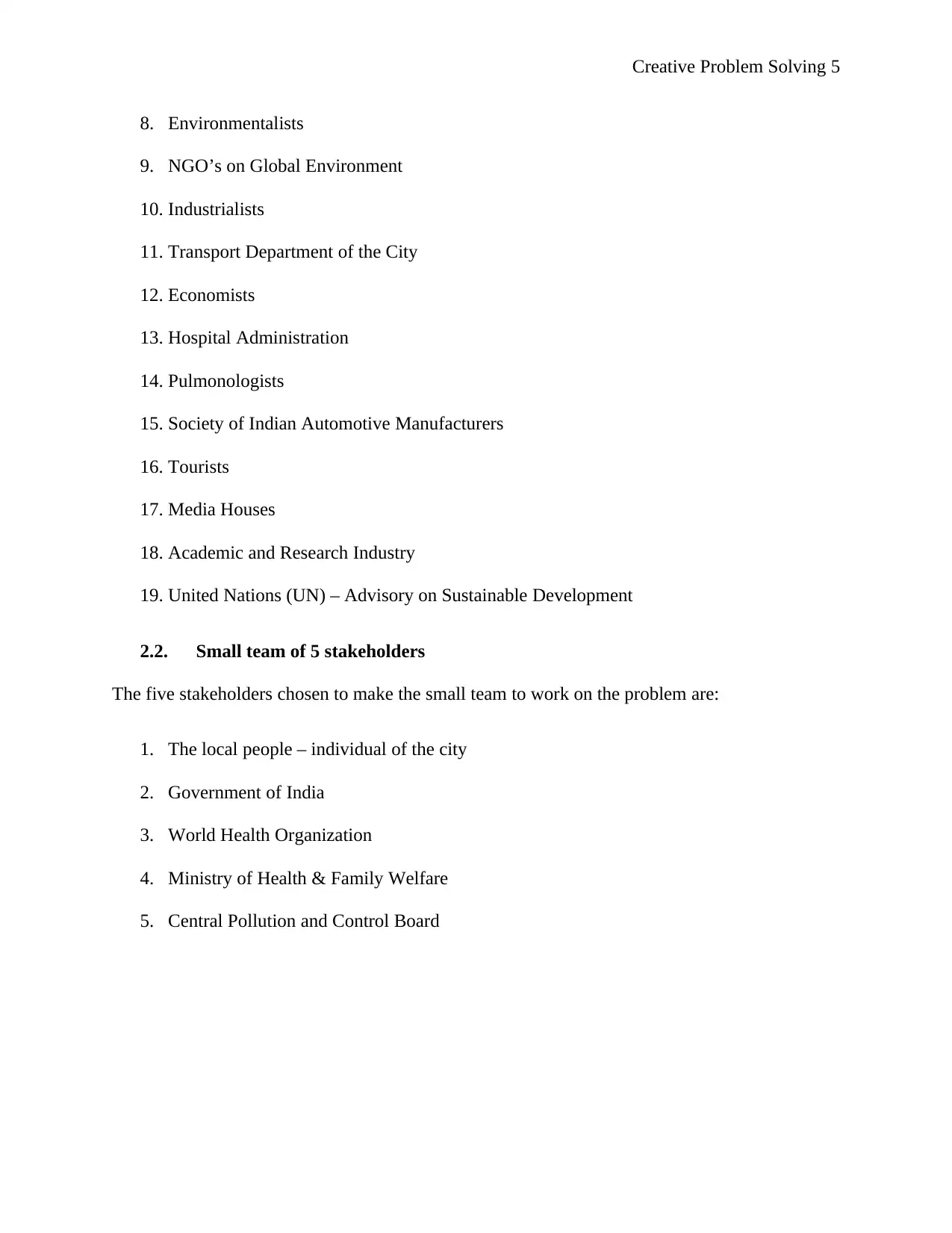
Creative Problem Solving 5
8. Environmentalists
9. NGO’s on Global Environment
10. Industrialists
11. Transport Department of the City
12. Economists
13. Hospital Administration
14. Pulmonologists
15. Society of Indian Automotive Manufacturers
16. Tourists
17. Media Houses
18. Academic and Research Industry
19. United Nations (UN) – Advisory on Sustainable Development
2.2. Small team of 5 stakeholders
The five stakeholders chosen to make the small team to work on the problem are:
1. The local people – individual of the city
2. Government of India
3. World Health Organization
4. Ministry of Health & Family Welfare
5. Central Pollution and Control Board
8. Environmentalists
9. NGO’s on Global Environment
10. Industrialists
11. Transport Department of the City
12. Economists
13. Hospital Administration
14. Pulmonologists
15. Society of Indian Automotive Manufacturers
16. Tourists
17. Media Houses
18. Academic and Research Industry
19. United Nations (UN) – Advisory on Sustainable Development
2.2. Small team of 5 stakeholders
The five stakeholders chosen to make the small team to work on the problem are:
1. The local people – individual of the city
2. Government of India
3. World Health Organization
4. Ministry of Health & Family Welfare
5. Central Pollution and Control Board
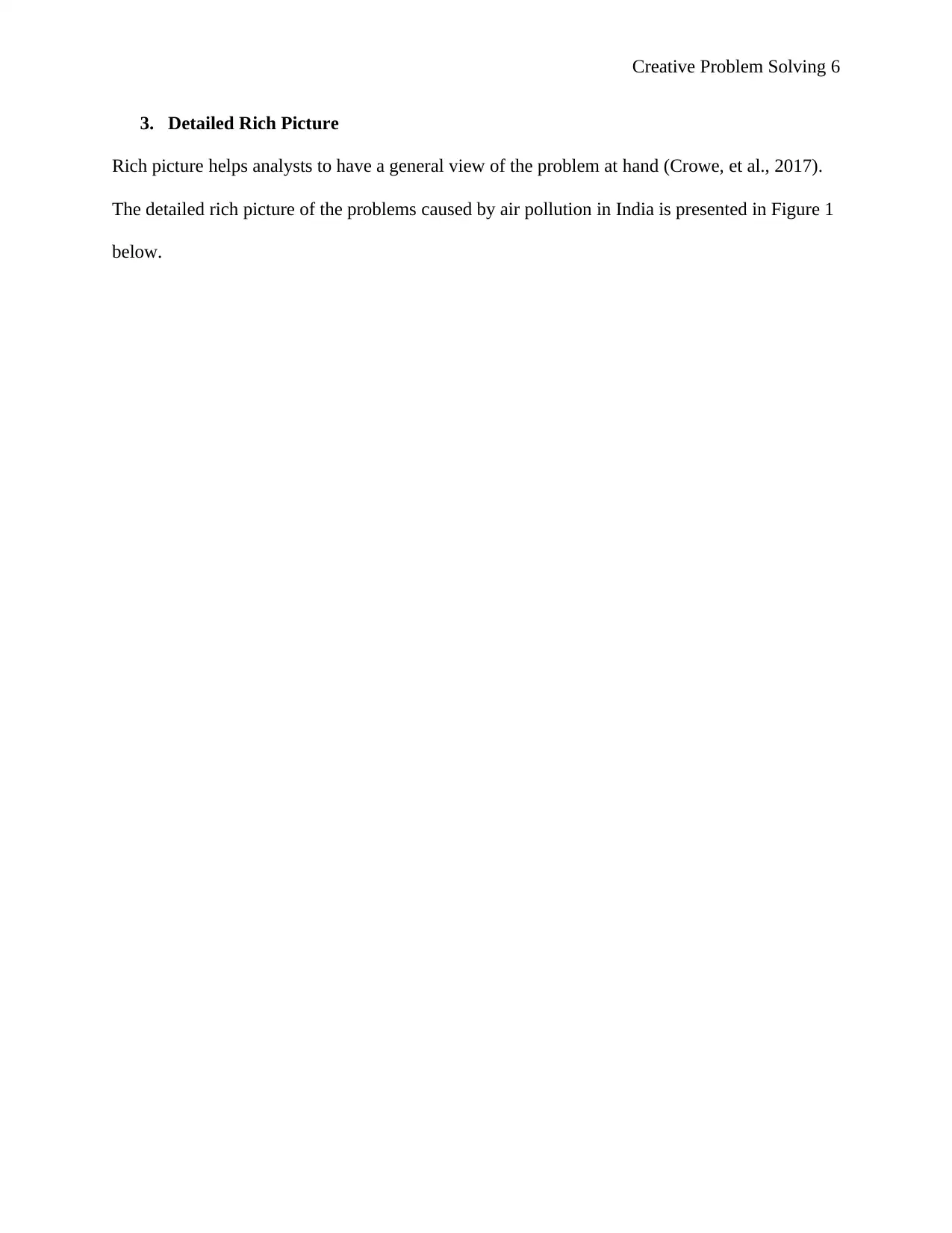
Creative Problem Solving 6
3. Detailed Rich Picture
Rich picture helps analysts to have a general view of the problem at hand (Crowe, et al., 2017).
The detailed rich picture of the problems caused by air pollution in India is presented in Figure 1
below.
3. Detailed Rich Picture
Rich picture helps analysts to have a general view of the problem at hand (Crowe, et al., 2017).
The detailed rich picture of the problems caused by air pollution in India is presented in Figure 1
below.
⊘ This is a preview!⊘
Do you want full access?
Subscribe today to unlock all pages.

Trusted by 1+ million students worldwide
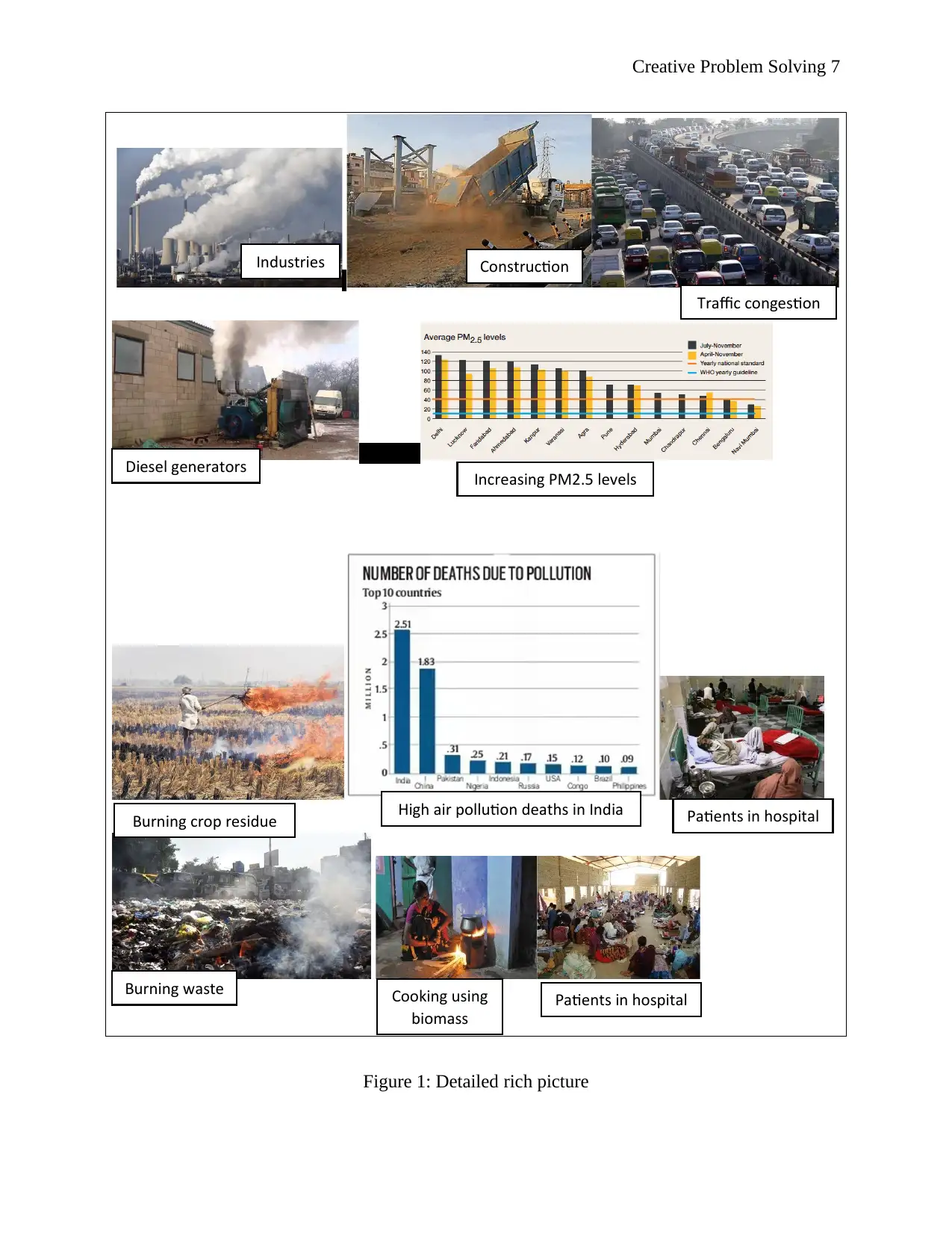
Creative Problem Solving 7
The
Figure 1: Detailed rich picture
Industries Construction
Diesel generators
Traffic congestion
Burning crop residue
Burning waste Cooking using
biomass
Patients in hospital
Patients in hospital
Increasing PM2.5 levels
High air pollution deaths in India
The
Figure 1: Detailed rich picture
Industries Construction
Diesel generators
Traffic congestion
Burning crop residue
Burning waste Cooking using
biomass
Patients in hospital
Patients in hospital
Increasing PM2.5 levels
High air pollution deaths in India
Paraphrase This Document
Need a fresh take? Get an instant paraphrase of this document with our AI Paraphraser
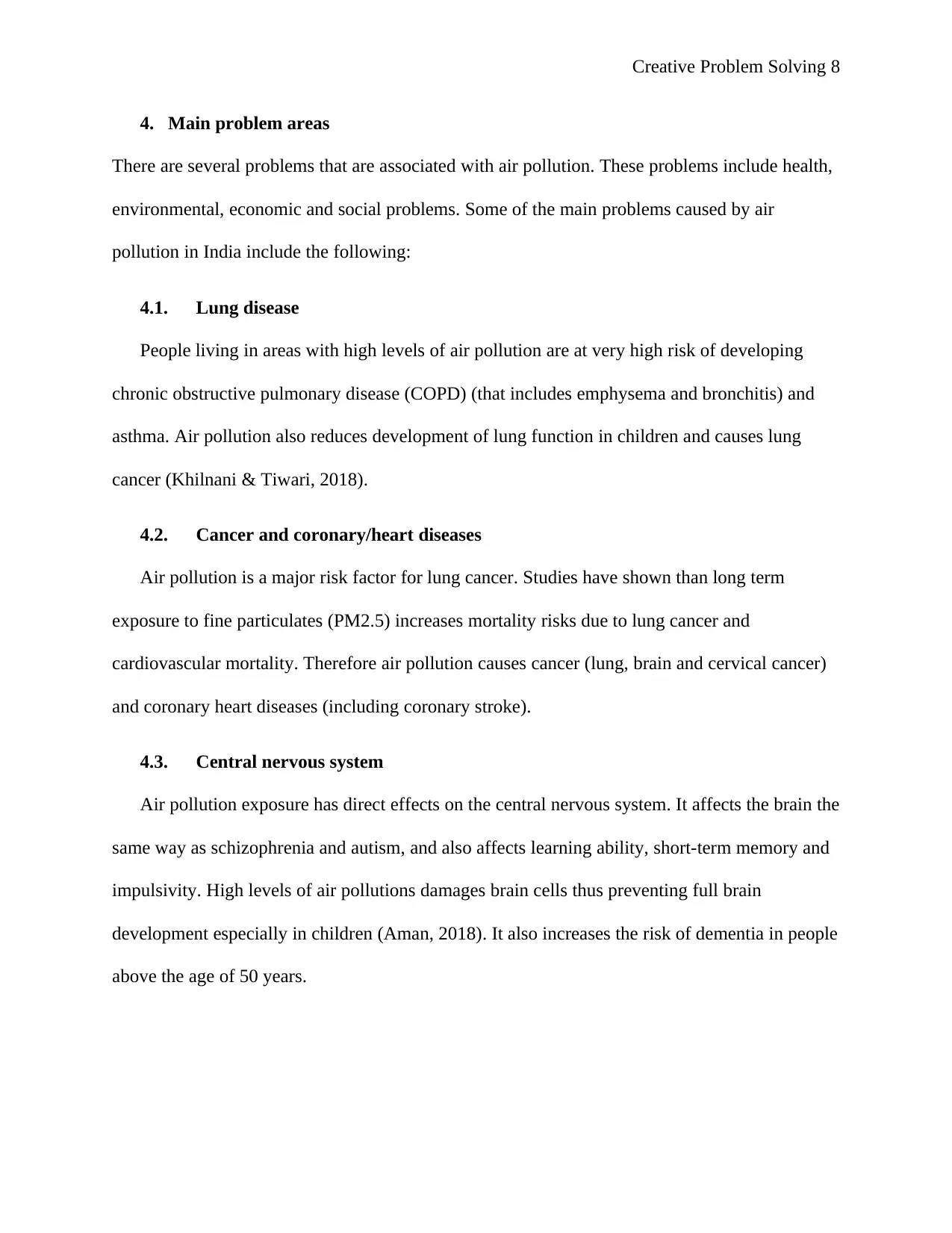
Creative Problem Solving 8
4. Main problem areas
There are several problems that are associated with air pollution. These problems include health,
environmental, economic and social problems. Some of the main problems caused by air
pollution in India include the following:
4.1. Lung disease
People living in areas with high levels of air pollution are at very high risk of developing
chronic obstructive pulmonary disease (COPD) (that includes emphysema and bronchitis) and
asthma. Air pollution also reduces development of lung function in children and causes lung
cancer (Khilnani & Tiwari, 2018).
4.2. Cancer and coronary/heart diseases
Air pollution is a major risk factor for lung cancer. Studies have shown than long term
exposure to fine particulates (PM2.5) increases mortality risks due to lung cancer and
cardiovascular mortality. Therefore air pollution causes cancer (lung, brain and cervical cancer)
and coronary heart diseases (including coronary stroke).
4.3. Central nervous system
Air pollution exposure has direct effects on the central nervous system. It affects the brain the
same way as schizophrenia and autism, and also affects learning ability, short-term memory and
impulsivity. High levels of air pollutions damages brain cells thus preventing full brain
development especially in children (Aman, 2018). It also increases the risk of dementia in people
above the age of 50 years.
4. Main problem areas
There are several problems that are associated with air pollution. These problems include health,
environmental, economic and social problems. Some of the main problems caused by air
pollution in India include the following:
4.1. Lung disease
People living in areas with high levels of air pollution are at very high risk of developing
chronic obstructive pulmonary disease (COPD) (that includes emphysema and bronchitis) and
asthma. Air pollution also reduces development of lung function in children and causes lung
cancer (Khilnani & Tiwari, 2018).
4.2. Cancer and coronary/heart diseases
Air pollution is a major risk factor for lung cancer. Studies have shown than long term
exposure to fine particulates (PM2.5) increases mortality risks due to lung cancer and
cardiovascular mortality. Therefore air pollution causes cancer (lung, brain and cervical cancer)
and coronary heart diseases (including coronary stroke).
4.3. Central nervous system
Air pollution exposure has direct effects on the central nervous system. It affects the brain the
same way as schizophrenia and autism, and also affects learning ability, short-term memory and
impulsivity. High levels of air pollutions damages brain cells thus preventing full brain
development especially in children (Aman, 2018). It also increases the risk of dementia in people
above the age of 50 years.
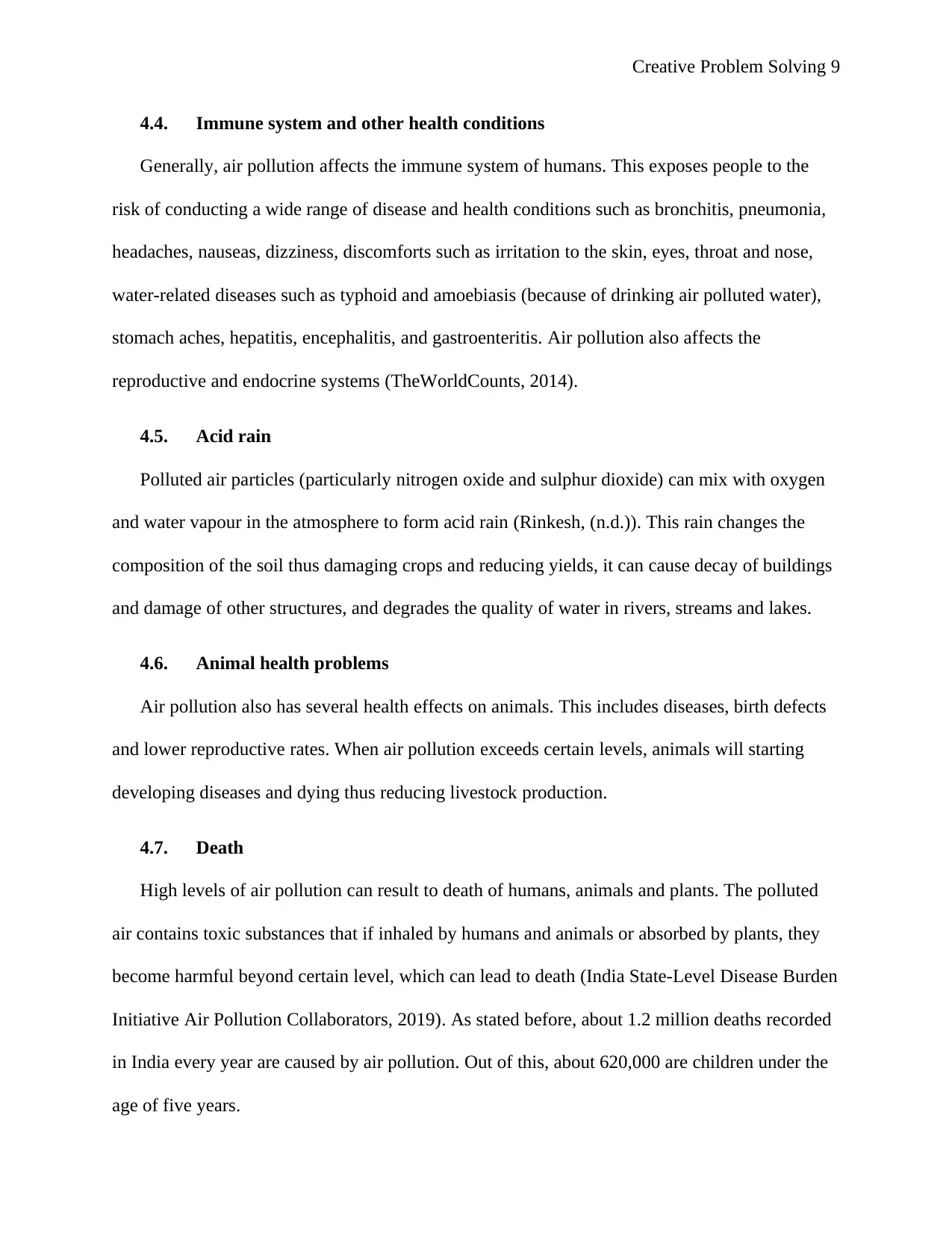
Creative Problem Solving 9
4.4. Immune system and other health conditions
Generally, air pollution affects the immune system of humans. This exposes people to the
risk of conducting a wide range of disease and health conditions such as bronchitis, pneumonia,
headaches, nauseas, dizziness, discomforts such as irritation to the skin, eyes, throat and nose,
water-related diseases such as typhoid and amoebiasis (because of drinking air polluted water),
stomach aches, hepatitis, encephalitis, and gastroenteritis. Air pollution also affects the
reproductive and endocrine systems (TheWorldCounts, 2014).
4.5. Acid rain
Polluted air particles (particularly nitrogen oxide and sulphur dioxide) can mix with oxygen
and water vapour in the atmosphere to form acid rain (Rinkesh, (n.d.)). This rain changes the
composition of the soil thus damaging crops and reducing yields, it can cause decay of buildings
and damage of other structures, and degrades the quality of water in rivers, streams and lakes.
4.6. Animal health problems
Air pollution also has several health effects on animals. This includes diseases, birth defects
and lower reproductive rates. When air pollution exceeds certain levels, animals will starting
developing diseases and dying thus reducing livestock production.
4.7. Death
High levels of air pollution can result to death of humans, animals and plants. The polluted
air contains toxic substances that if inhaled by humans and animals or absorbed by plants, they
become harmful beyond certain level, which can lead to death (India State-Level Disease Burden
Initiative Air Pollution Collaborators, 2019). As stated before, about 1.2 million deaths recorded
in India every year are caused by air pollution. Out of this, about 620,000 are children under the
age of five years.
4.4. Immune system and other health conditions
Generally, air pollution affects the immune system of humans. This exposes people to the
risk of conducting a wide range of disease and health conditions such as bronchitis, pneumonia,
headaches, nauseas, dizziness, discomforts such as irritation to the skin, eyes, throat and nose,
water-related diseases such as typhoid and amoebiasis (because of drinking air polluted water),
stomach aches, hepatitis, encephalitis, and gastroenteritis. Air pollution also affects the
reproductive and endocrine systems (TheWorldCounts, 2014).
4.5. Acid rain
Polluted air particles (particularly nitrogen oxide and sulphur dioxide) can mix with oxygen
and water vapour in the atmosphere to form acid rain (Rinkesh, (n.d.)). This rain changes the
composition of the soil thus damaging crops and reducing yields, it can cause decay of buildings
and damage of other structures, and degrades the quality of water in rivers, streams and lakes.
4.6. Animal health problems
Air pollution also has several health effects on animals. This includes diseases, birth defects
and lower reproductive rates. When air pollution exceeds certain levels, animals will starting
developing diseases and dying thus reducing livestock production.
4.7. Death
High levels of air pollution can result to death of humans, animals and plants. The polluted
air contains toxic substances that if inhaled by humans and animals or absorbed by plants, they
become harmful beyond certain level, which can lead to death (India State-Level Disease Burden
Initiative Air Pollution Collaborators, 2019). As stated before, about 1.2 million deaths recorded
in India every year are caused by air pollution. Out of this, about 620,000 are children under the
age of five years.
⊘ This is a preview!⊘
Do you want full access?
Subscribe today to unlock all pages.

Trusted by 1+ million students worldwide
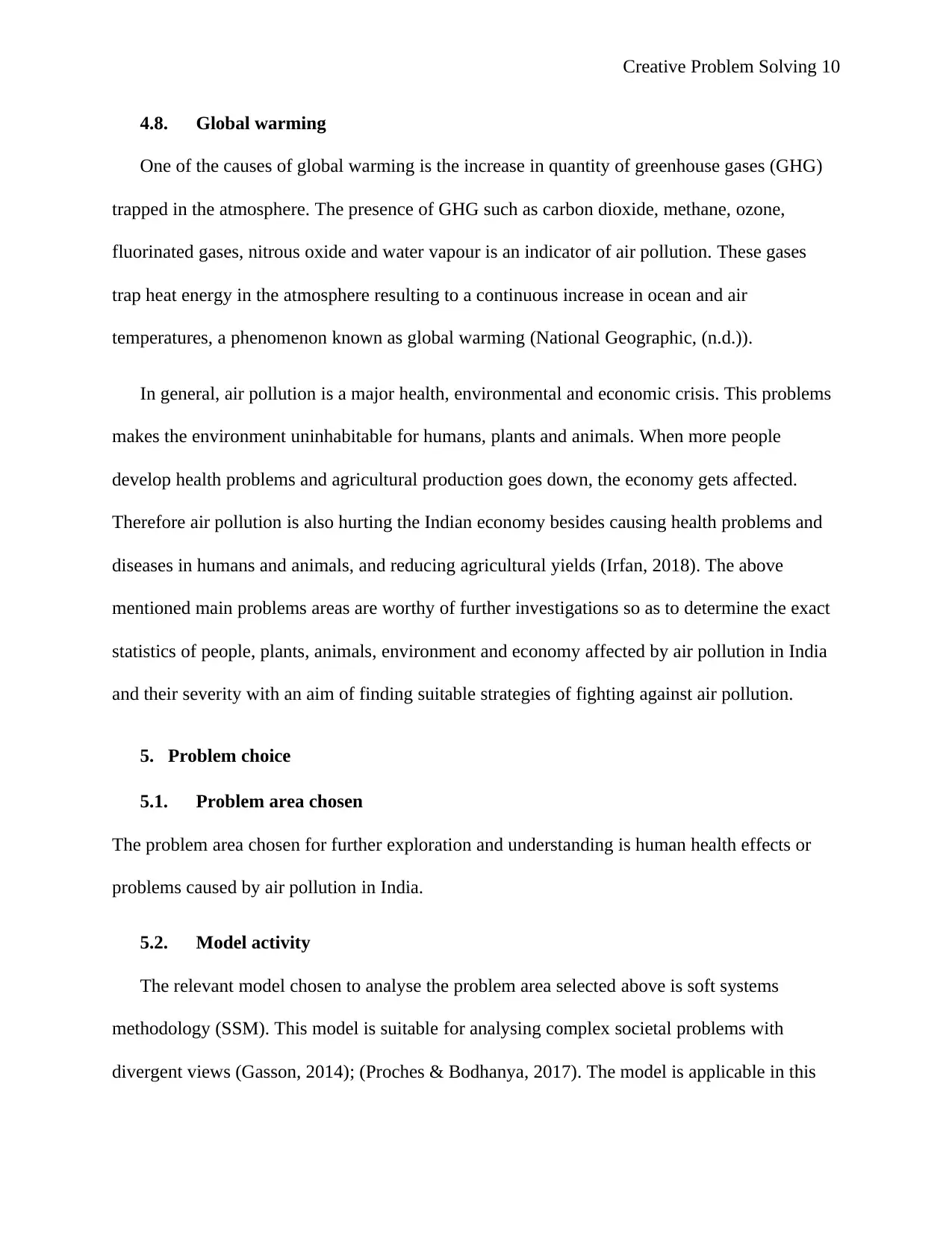
Creative Problem Solving 10
4.8. Global warming
One of the causes of global warming is the increase in quantity of greenhouse gases (GHG)
trapped in the atmosphere. The presence of GHG such as carbon dioxide, methane, ozone,
fluorinated gases, nitrous oxide and water vapour is an indicator of air pollution. These gases
trap heat energy in the atmosphere resulting to a continuous increase in ocean and air
temperatures, a phenomenon known as global warming (National Geographic, (n.d.)).
In general, air pollution is a major health, environmental and economic crisis. This problems
makes the environment uninhabitable for humans, plants and animals. When more people
develop health problems and agricultural production goes down, the economy gets affected.
Therefore air pollution is also hurting the Indian economy besides causing health problems and
diseases in humans and animals, and reducing agricultural yields (Irfan, 2018). The above
mentioned main problems areas are worthy of further investigations so as to determine the exact
statistics of people, plants, animals, environment and economy affected by air pollution in India
and their severity with an aim of finding suitable strategies of fighting against air pollution.
5. Problem choice
5.1. Problem area chosen
The problem area chosen for further exploration and understanding is human health effects or
problems caused by air pollution in India.
5.2. Model activity
The relevant model chosen to analyse the problem area selected above is soft systems
methodology (SSM). This model is suitable for analysing complex societal problems with
divergent views (Gasson, 2014); (Proches & Bodhanya, 2017). The model is applicable in this
4.8. Global warming
One of the causes of global warming is the increase in quantity of greenhouse gases (GHG)
trapped in the atmosphere. The presence of GHG such as carbon dioxide, methane, ozone,
fluorinated gases, nitrous oxide and water vapour is an indicator of air pollution. These gases
trap heat energy in the atmosphere resulting to a continuous increase in ocean and air
temperatures, a phenomenon known as global warming (National Geographic, (n.d.)).
In general, air pollution is a major health, environmental and economic crisis. This problems
makes the environment uninhabitable for humans, plants and animals. When more people
develop health problems and agricultural production goes down, the economy gets affected.
Therefore air pollution is also hurting the Indian economy besides causing health problems and
diseases in humans and animals, and reducing agricultural yields (Irfan, 2018). The above
mentioned main problems areas are worthy of further investigations so as to determine the exact
statistics of people, plants, animals, environment and economy affected by air pollution in India
and their severity with an aim of finding suitable strategies of fighting against air pollution.
5. Problem choice
5.1. Problem area chosen
The problem area chosen for further exploration and understanding is human health effects or
problems caused by air pollution in India.
5.2. Model activity
The relevant model chosen to analyse the problem area selected above is soft systems
methodology (SSM). This model is suitable for analysing complex societal problems with
divergent views (Gasson, 2014); (Proches & Bodhanya, 2017). The model is applicable in this
Paraphrase This Document
Need a fresh take? Get an instant paraphrase of this document with our AI Paraphraser
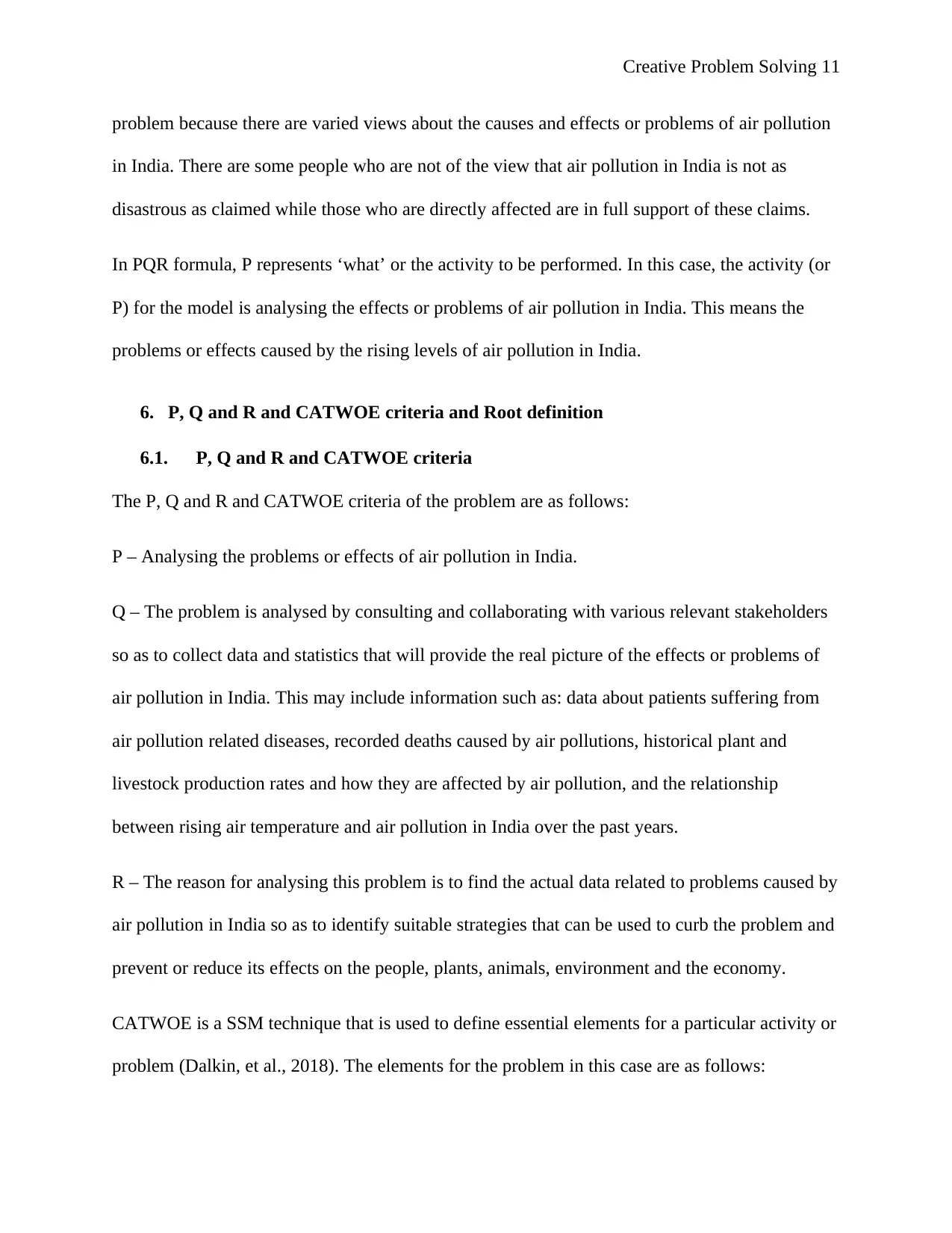
Creative Problem Solving 11
problem because there are varied views about the causes and effects or problems of air pollution
in India. There are some people who are not of the view that air pollution in India is not as
disastrous as claimed while those who are directly affected are in full support of these claims.
In PQR formula, P represents ‘what’ or the activity to be performed. In this case, the activity (or
P) for the model is analysing the effects or problems of air pollution in India. This means the
problems or effects caused by the rising levels of air pollution in India.
6. P, Q and R and CATWOE criteria and Root definition
6.1. P, Q and R and CATWOE criteria
The P, Q and R and CATWOE criteria of the problem are as follows:
P – Analysing the problems or effects of air pollution in India.
Q – The problem is analysed by consulting and collaborating with various relevant stakeholders
so as to collect data and statistics that will provide the real picture of the effects or problems of
air pollution in India. This may include information such as: data about patients suffering from
air pollution related diseases, recorded deaths caused by air pollutions, historical plant and
livestock production rates and how they are affected by air pollution, and the relationship
between rising air temperature and air pollution in India over the past years.
R – The reason for analysing this problem is to find the actual data related to problems caused by
air pollution in India so as to identify suitable strategies that can be used to curb the problem and
prevent or reduce its effects on the people, plants, animals, environment and the economy.
CATWOE is a SSM technique that is used to define essential elements for a particular activity or
problem (Dalkin, et al., 2018). The elements for the problem in this case are as follows:
problem because there are varied views about the causes and effects or problems of air pollution
in India. There are some people who are not of the view that air pollution in India is not as
disastrous as claimed while those who are directly affected are in full support of these claims.
In PQR formula, P represents ‘what’ or the activity to be performed. In this case, the activity (or
P) for the model is analysing the effects or problems of air pollution in India. This means the
problems or effects caused by the rising levels of air pollution in India.
6. P, Q and R and CATWOE criteria and Root definition
6.1. P, Q and R and CATWOE criteria
The P, Q and R and CATWOE criteria of the problem are as follows:
P – Analysing the problems or effects of air pollution in India.
Q – The problem is analysed by consulting and collaborating with various relevant stakeholders
so as to collect data and statistics that will provide the real picture of the effects or problems of
air pollution in India. This may include information such as: data about patients suffering from
air pollution related diseases, recorded deaths caused by air pollutions, historical plant and
livestock production rates and how they are affected by air pollution, and the relationship
between rising air temperature and air pollution in India over the past years.
R – The reason for analysing this problem is to find the actual data related to problems caused by
air pollution in India so as to identify suitable strategies that can be used to curb the problem and
prevent or reduce its effects on the people, plants, animals, environment and the economy.
CATWOE is a SSM technique that is used to define essential elements for a particular activity or
problem (Dalkin, et al., 2018). The elements for the problem in this case are as follows:
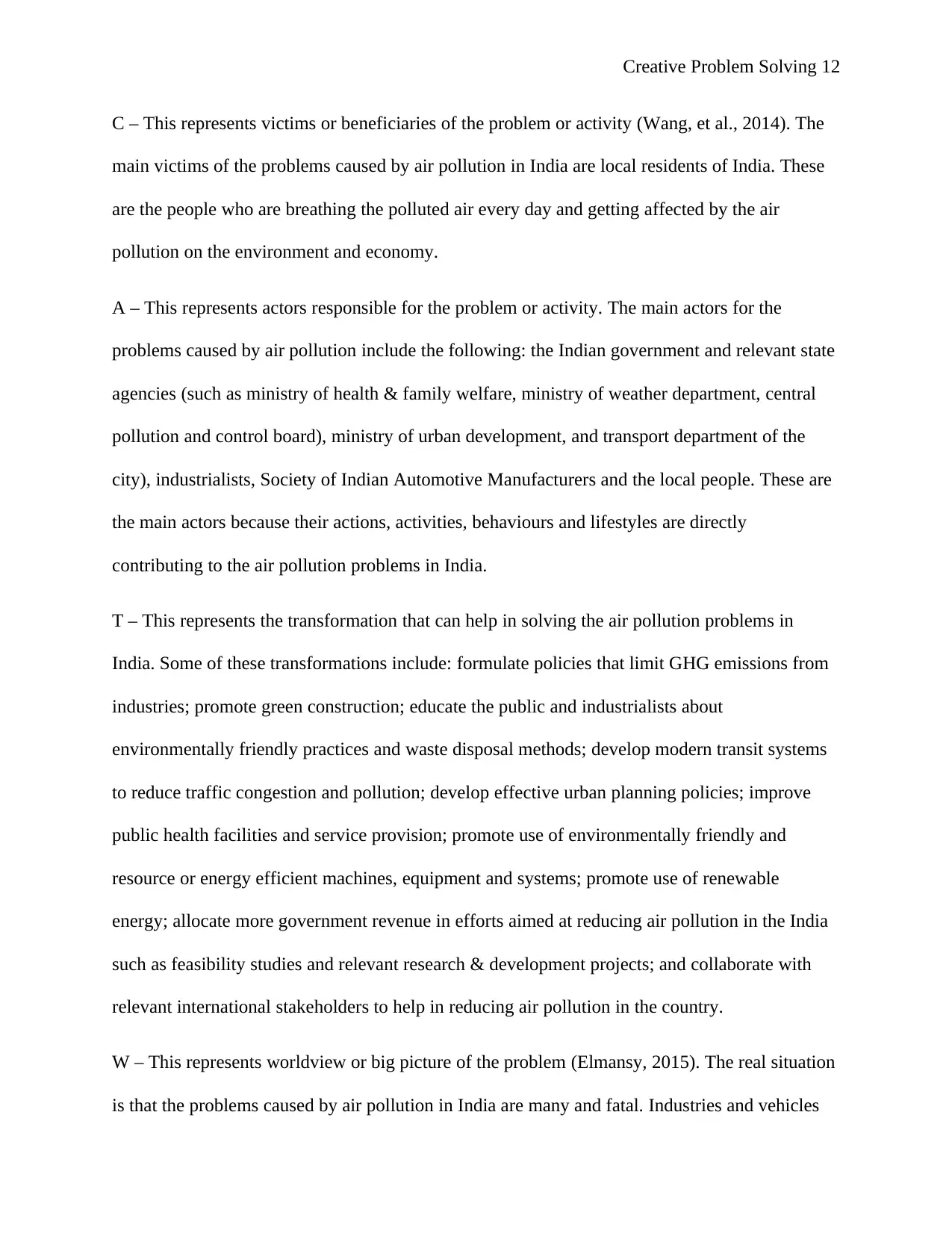
Creative Problem Solving 12
C – This represents victims or beneficiaries of the problem or activity (Wang, et al., 2014). The
main victims of the problems caused by air pollution in India are local residents of India. These
are the people who are breathing the polluted air every day and getting affected by the air
pollution on the environment and economy.
A – This represents actors responsible for the problem or activity. The main actors for the
problems caused by air pollution include the following: the Indian government and relevant state
agencies (such as ministry of health & family welfare, ministry of weather department, central
pollution and control board), ministry of urban development, and transport department of the
city), industrialists, Society of Indian Automotive Manufacturers and the local people. These are
the main actors because their actions, activities, behaviours and lifestyles are directly
contributing to the air pollution problems in India.
T – This represents the transformation that can help in solving the air pollution problems in
India. Some of these transformations include: formulate policies that limit GHG emissions from
industries; promote green construction; educate the public and industrialists about
environmentally friendly practices and waste disposal methods; develop modern transit systems
to reduce traffic congestion and pollution; develop effective urban planning policies; improve
public health facilities and service provision; promote use of environmentally friendly and
resource or energy efficient machines, equipment and systems; promote use of renewable
energy; allocate more government revenue in efforts aimed at reducing air pollution in the India
such as feasibility studies and relevant research & development projects; and collaborate with
relevant international stakeholders to help in reducing air pollution in the country.
W – This represents worldview or big picture of the problem (Elmansy, 2015). The real situation
is that the problems caused by air pollution in India are many and fatal. Industries and vehicles
C – This represents victims or beneficiaries of the problem or activity (Wang, et al., 2014). The
main victims of the problems caused by air pollution in India are local residents of India. These
are the people who are breathing the polluted air every day and getting affected by the air
pollution on the environment and economy.
A – This represents actors responsible for the problem or activity. The main actors for the
problems caused by air pollution include the following: the Indian government and relevant state
agencies (such as ministry of health & family welfare, ministry of weather department, central
pollution and control board), ministry of urban development, and transport department of the
city), industrialists, Society of Indian Automotive Manufacturers and the local people. These are
the main actors because their actions, activities, behaviours and lifestyles are directly
contributing to the air pollution problems in India.
T – This represents the transformation that can help in solving the air pollution problems in
India. Some of these transformations include: formulate policies that limit GHG emissions from
industries; promote green construction; educate the public and industrialists about
environmentally friendly practices and waste disposal methods; develop modern transit systems
to reduce traffic congestion and pollution; develop effective urban planning policies; improve
public health facilities and service provision; promote use of environmentally friendly and
resource or energy efficient machines, equipment and systems; promote use of renewable
energy; allocate more government revenue in efforts aimed at reducing air pollution in the India
such as feasibility studies and relevant research & development projects; and collaborate with
relevant international stakeholders to help in reducing air pollution in the country.
W – This represents worldview or big picture of the problem (Elmansy, 2015). The real situation
is that the problems caused by air pollution in India are many and fatal. Industries and vehicles
⊘ This is a preview!⊘
Do you want full access?
Subscribe today to unlock all pages.

Trusted by 1+ million students worldwide
1 out of 22
Related Documents
Your All-in-One AI-Powered Toolkit for Academic Success.
+13062052269
info@desklib.com
Available 24*7 on WhatsApp / Email
![[object Object]](/_next/static/media/star-bottom.7253800d.svg)
Unlock your academic potential
Copyright © 2020–2025 A2Z Services. All Rights Reserved. Developed and managed by ZUCOL.




